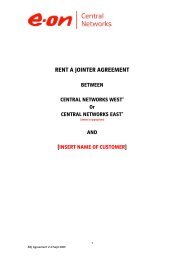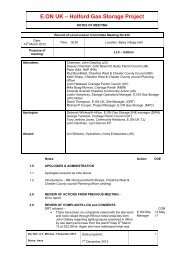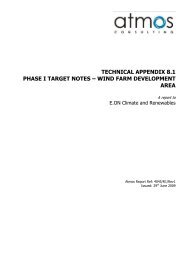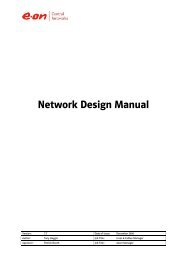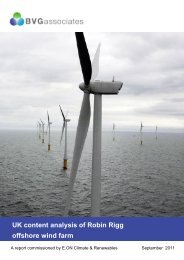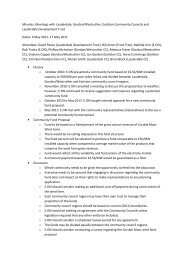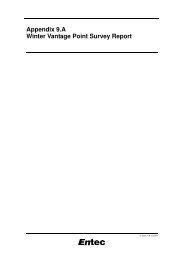Cable Laying Requirements - E.ON UK
Cable Laying Requirements - E.ON UK
Cable Laying Requirements - E.ON UK
You also want an ePaper? Increase the reach of your titles
YUMPU automatically turns print PDFs into web optimized ePapers that Google loves.
Purpose<br />
Scope<br />
Application Guide<br />
<strong>Cable</strong> <strong>Laying</strong> <strong>Requirements</strong><br />
Reference CNAG 09-CL<br />
Issue date April 2010<br />
Version 5.6<br />
Pages 29<br />
This Application Guide defines the technical requirements to be achieved<br />
by the cable installer together with the constraints necessary to ensure the<br />
integrity of the final installation.<br />
Approved materials and other useful information is contained within the<br />
appendixes.<br />
The cable installer shall be responsible for developing and maintaining<br />
method statements to install cables to meet the requirements of this<br />
Application Guide.<br />
This Specification refers to:<br />
Low Voltage <strong>Cable</strong>s<br />
Medium Voltage (6.6kV, 11kV & 33kV) <strong>Cable</strong>s<br />
used on Central Networks LV & MV Underground Network<br />
Audience E.<strong>ON</strong> Central Networks, E.<strong>ON</strong> <strong>UK</strong> Business Services, E.<strong>ON</strong> Energy<br />
Services and their service providers and contractors.<br />
Review Date 1 April 2013<br />
Independent Connections Providers<br />
Restrictions: None<br />
Owner Network Standards<br />
Related Documents • Central Networks Network Design Manual<br />
• General Health & Safety Manual Section 18.4 “Arrangements on<br />
Safe Excavation”<br />
Version Prepaired by Approvded by<br />
Issue Date<br />
5.6 T Haggis & T Dutton M Simpson April 2010
Revision Log<br />
CNAG 09-CL<br />
Application Guide<br />
<strong>Cable</strong> <strong>Laying</strong> <strong>Requirements</strong><br />
Version Prepared by Checked by Approved by Reviewed By Date<br />
5.6 Tony Haggis Terry Dutton M Simpson N/A April 2010<br />
Senior Senior <strong>Cable</strong><br />
Overhead Line<br />
Specialist<br />
Specialist<br />
Notes: 2.2.1 – Reference to General Health & Safety Manual Section 18.4 “Arrangements on<br />
Safe Excavation”<br />
3.2 Protection of <strong>Cable</strong>s by Ducts and Tapes – NEW CABLE PROTECTI<strong>ON</strong> POLICY<br />
INCLUDING LAID DIRECT AND SOLID WALL DUCT OPTI<strong>ON</strong>S<br />
Appendix A2 – Laid Direct - <strong>Cable</strong>s Laid Along Footpaths and PPG 3 Road/Footpaths<br />
NEW DRAWINGS<br />
APPENDIX H2 Transformer 33kV Tails – NEW APPENDIX ADDED<br />
Appendix I Technical details of Duct, Marker Tapes Tiles etc. – NEW APPENDIX<br />
ADDED<br />
Changes made in version 5.5<br />
Date Section Notes about the change<br />
01/12/2006 All <strong>Cable</strong> <strong>Laying</strong><br />
Technical<br />
<strong>Requirements</strong><br />
Re-branded to E.<strong>ON</strong> Central Networks.<br />
Changes made in version 5.4<br />
Date Section Notes about the change<br />
23/02/2006 All <strong>Cable</strong> <strong>Laying</strong><br />
Technical<br />
<strong>Requirements</strong><br />
Changes made in version 5.3<br />
<strong>Cable</strong> <strong>Laying</strong> Technical <strong>Requirements</strong> extracted from <strong>Cable</strong>s &<br />
<strong>Cable</strong> <strong>Laying</strong> Accessories Manual as it now applies to both East<br />
and West and resides in COMBINED Central Networks. The<br />
<strong>Cable</strong>s & <strong>Cable</strong> <strong>Laying</strong> Accessories Manual remains application<br />
to East only and resides in EAST Central Networks.<br />
Date Section Notes about the change<br />
2/09/2005 32.1 Paragraph re-worded “All Central Networks’ cables installed in<br />
the public environment shall be laid in black rigid corrugated<br />
ducts complying with ENATS 12-24 together with warning tape<br />
or tiles. <strong>Cable</strong>s may be laid without ducts inside substations.”<br />
Version 5.6 Date of Issue – April 2010 Page 2 of 29<br />
The current version of the this document resides in the E.<strong>ON</strong> <strong>UK</strong> Documentum database<br />
CAUTI<strong>ON</strong> – any other copy in electronic, printed or other formats may be out of date<br />
© Central Networks plc
Changes made in version 5.1<br />
Date Section Notes about the change<br />
18/02/2005 31.2 Reference included to PPG3 residential sites<br />
32.3<br />
Appendix A<br />
Appendix C<br />
Changes made in version 5<br />
CNAG 09-CL<br />
Application Guide<br />
<strong>Cable</strong> <strong>Laying</strong> <strong>Requirements</strong><br />
<strong>Requirements</strong> for spacing between ducts for blinding /<br />
consolidation explained.<br />
Changed to read ‘<strong>Cable</strong>s Laid Along Footpaths and PPG 3<br />
Road/Footpaths’<br />
Changed to read ‘<strong>Cable</strong>s Laid Across and Along Roads’<br />
Date Section Notes about the change<br />
10/11/2004 All<br />
Appendices<br />
A,B,C<br />
Appendix H<br />
Document modified to reflect adoption of ducting all cables.<br />
Duct cable drawings added<br />
Added showing spacing of 11kV transformer tails<br />
Changes made in version 4<br />
Date Section Notes about the change<br />
24/11/2003 Section 1 22.1 Specification added to 33kV tiles.<br />
Appendix G<br />
Changes made in version 3<br />
Joint hole dimensions & text amended.<br />
Date Section Notes about the change<br />
13/11/2002 Paragraph 32.3 Amendments to requirements for ducts, tapes & tiles due to<br />
introduction of Electricity Safety, Quality and Continuity<br />
Regulations 2002.<br />
Appendices A,B<br />
&C<br />
Appendix D<br />
Appendix G<br />
Amendments to drawings showing changes as a result of<br />
Paragraph 32.3<br />
Changes to duct size for 70mm 2 Triplex 11kV cable.<br />
Contractors’ item codes removed (no longer needed).<br />
Version 5.6 Date of Issue – April 2010 Page 3 of 29<br />
The current version of the this document resides in the E.<strong>ON</strong> <strong>UK</strong> Documentum database<br />
CAUTI<strong>ON</strong> – any other copy in electronic, printed or other formats may be out of date<br />
© Central Networks plc
Changes made in version 2<br />
Date Section Notes about the change<br />
May 2002 Section 32.3 Specification added to 33kV tiles.<br />
Appendix G<br />
Changes made in version 1<br />
Joint hole dimensions & text amended.<br />
Date Section Notes about the change<br />
Feb 2001 <strong>Cable</strong> <strong>Laying</strong><br />
Technical<br />
<strong>Requirements</strong><br />
CNAG 09-CL<br />
Application Guide<br />
<strong>Cable</strong> <strong>Laying</strong> <strong>Requirements</strong><br />
<strong>Cable</strong> <strong>Laying</strong> Technical <strong>Requirements</strong> added to <strong>Cable</strong>s & <strong>Cable</strong><br />
<strong>Laying</strong> Accessories Manual.<br />
Version 5.6 Date of Issue – April 2010 Page 4 of 29<br />
The current version of the this document resides in the E.<strong>ON</strong> <strong>UK</strong> Documentum database<br />
CAUTI<strong>ON</strong> – any other copy in electronic, printed or other formats may be out of date<br />
© Central Networks plc
C<strong>ON</strong>TENTS<br />
CNAG 09-CL<br />
Application Guide<br />
<strong>Cable</strong> <strong>Laying</strong> <strong>Requirements</strong><br />
C<strong>ON</strong>TENTS .................................................................................................................................. 5<br />
1. INTRODUCTI<strong>ON</strong> .............................................................................................................. 7<br />
2. EXCAVATI<strong>ON</strong> ................................................................................................................... 7<br />
2.1 Signing & Guarding ..................................................................................................... 7<br />
2.2 Excavation ...................................................................................................................... 8<br />
2.3 Reinstatement ................................................................................................................. 8<br />
3. CABLE INSTALLATI<strong>ON</strong> ................................................................................................. 8<br />
3.1 Depth & Spacing ........................................................................................................... 8<br />
3.2 Protection of <strong>Cable</strong>s by Ducts and Tapes .............................................................. 9<br />
3.3 Pulling in cables .......................................................................................................... 14<br />
4. EARTHING AND B<strong>ON</strong>DING OF SINGLE CORE CABLES ........................................ 15<br />
4.1 LV <strong>Cable</strong>s ..................................................................................................................... 15<br />
4.2 Three Core <strong>Cable</strong>s ....................................................................................................... 15<br />
4.3 Single Core <strong>Cable</strong>s ....................................................................................................... 15<br />
APPENDIX A1 - DUCTED .................................................................................................... 17<br />
<strong>Cable</strong>s Laid Along Footpaths and PPG 3 Road/Footpaths ........................................ 17<br />
APPENDIX A2 – LAID DIRECT ........................................................................................... 18<br />
<strong>Cable</strong>s Laid Along Footpaths and PPG 3 Road/Footpaths ........................................ 18<br />
APPENDIX B .......................................................................................................................... 19<br />
Version 5.6 Date of Issue – April 2010 Page 5 of 29<br />
The current version of the this document resides in the E.<strong>ON</strong> <strong>UK</strong> Documentum database<br />
CAUTI<strong>ON</strong> – any other copy in electronic, printed or other formats may be out of date<br />
© Central Networks plc
CNAG 09-CL<br />
Application Guide<br />
<strong>Cable</strong> <strong>Laying</strong> <strong>Requirements</strong><br />
<strong>Cable</strong> Laid in Agricultural Land ........................................................................................ 19<br />
APPENDIX C ......................................................................................................................... 20<br />
<strong>Cable</strong>s Laid Across and Along Roads ........................................................................... 20<br />
APPENDIX D .......................................................................................................................... 21<br />
Standard Duct Sizes ............................................................................................................ 21<br />
APPENDIX E ......................................................................................................................... 22<br />
Minimum Bending Radii .................................................................................................... 22<br />
APPENDIX F ......................................................................................................................... 23<br />
Mechanical Pulling-in Tensions ....................................................................................... 23<br />
APPENDIX G ......................................................................................................................... 24<br />
Joint Hole Dimensions ....................................................................................................... 24<br />
APPENDIX H1 ....................................................................................................................... 25<br />
Transformer 11kV Tails ...................................................................................................... 25<br />
APPENDIX H2 ....................................................................................................................... 26<br />
Transformer 33kV Tails ...................................................................................................... 26<br />
APPENDIX I ........................................................................................................................... 27<br />
Technical details of Duct, Marker Tapes Tiles etc. ..................................................... 27<br />
Version 5.6 Date of Issue – April 2010 Page 6 of 29<br />
The current version of the this document resides in the E.<strong>ON</strong> <strong>UK</strong> Documentum database<br />
CAUTI<strong>ON</strong> – any other copy in electronic, printed or other formats may be out of date<br />
© Central Networks plc
TECHNICAL REQUIREMENTS: <strong>Cable</strong> <strong>Laying</strong><br />
1. Introduction<br />
CNAG 09-CL<br />
Application Guide<br />
<strong>Cable</strong> <strong>Laying</strong> <strong>Requirements</strong><br />
1.1.1 This Application Guide defines the technical requirements to be achieved by the<br />
cable installer together with the constraints necessary to ensure the integrity of<br />
the final installation.<br />
1.1.2 The cable installer shall be responsible for developing and maintaining method<br />
statements to install cables to meet the requirements of this Application Guide.<br />
1.1.3 Central Networks may approve or reject the cable installer’s method statements<br />
in accordance with the provisions of the Contract.<br />
2. Excavation<br />
2.1 Signing & Guarding<br />
2.1.1 Public highway<br />
All Works carried out shall comply with:<br />
1. New Roads and Street Works Act 1991 “Safety at Street Works and<br />
Road Works” code of practice.<br />
2. “Chapter 8 of the Traffic Signs Manual” published by the Dept. of<br />
Transport.<br />
2.1.2 Private land<br />
All works carried out shall be protected to the same degree as 21.1 unless<br />
otherwise agreed by the landowner.<br />
2.1.3 Agricultural land<br />
In addition to 21.1 and 21.2 the <strong>Cable</strong> Installer may use electric fencing to<br />
protect livestock from the Works provided that:<br />
• The <strong>Cable</strong> Installer obtains permission from the owner of the livestock<br />
and the landowner or tenant.<br />
• The electric fencing displays warning signs at a minimum of every 2<br />
meters.<br />
2.1.4 Courtesy Boards<br />
A the <strong>Cable</strong> Installer shall provide and display a courtesy board at each Site<br />
showing:<br />
• the <strong>Cable</strong> Installer’s name<br />
• Central Networks’ name and 24 hour telephone number<br />
Version 5.6 Date of Issue – April 2010 Page 7 of 29<br />
The current version of the this document resides in the E.<strong>ON</strong> <strong>UK</strong> Documentum database<br />
CAUTI<strong>ON</strong> – any other copy in electronic, printed or other formats may be out of date<br />
© Central Networks plc
CNAG 09-CL<br />
Application Guide<br />
<strong>Cable</strong> <strong>Laying</strong> <strong>Requirements</strong><br />
• An approved apology message on behalf of Central Networks.<br />
2.2 Excavation<br />
2.2.1 Safe Excavation<br />
Operatives shall be conversant with Central Networks General Health & Safety<br />
Manual Section 18.4 “Arrangements on Safe Excavation”.<br />
Prior to excavation the <strong>Cable</strong> Installer shall consult the plans of all utilities plant<br />
and then confirm their position by use of suitable instruments.<br />
Important Note. <strong>Cable</strong>s belonging to Independent Distribution Network<br />
Operators (IDNO) are now present in many locations alongside Central<br />
Networks cables. IDNO cables are NOT SHOWN on Central Networks records.<br />
The <strong>Cable</strong> Installer will need to obtain cable records from the IDNOs operating<br />
networks in the locality.<br />
2.2.2 Excavation shall be carried out in accordance with the “HAUC Specification for<br />
the Reinstatement of Opening in Highways” document section S3 and Guidance<br />
Document HS(G)47 "Avoiding Danger from Underground Services" issued by<br />
the Health and Safety Executive.<br />
2.2.3 Trench dimensions are not specified but shall be sufficient to allow the <strong>Cable</strong><br />
Installer to install the ducts and cables:<br />
• at the depth and spacing specified<br />
• within the bending radii specified<br />
• within the pulling tensions specified<br />
• without damage to the cable sheaths<br />
2.3 Reinstatement<br />
2.3.1 Reinstatement shall be carried out in accordance with the “HAUC Specification<br />
for the Reinstatement of Opening in Highways” document sections S5 to S10.<br />
2.3.2 Previously excavated materials may be used as back-fill. It is the responsibility<br />
of the <strong>Cable</strong> Installer to assure the suitability of the materials for re-use and this<br />
procedure shall be included in his method statement.<br />
2.3.3 There shall be a minimum separation of 25mm between adjacent ducts and<br />
between ducts and the trench side to enable proper consolidation of blinding<br />
material around, under and between ducts (except 33kV see section 32.2).<br />
3. <strong>Cable</strong> Installation<br />
3.1 Depth & Spacing<br />
3.1.1 Appendices A1, A2, B & C show the final physical positions of cables and ducts<br />
to be achieved in relation to finished ground level. The <strong>Cable</strong> Installer shall<br />
determine the size of excavation required to achieve the result.<br />
Version 5.6 Date of Issue – April 2010 Page 8 of 29<br />
The current version of the this document resides in the E.<strong>ON</strong> <strong>UK</strong> Documentum database<br />
CAUTI<strong>ON</strong> – any other copy in electronic, printed or other formats may be out of date<br />
© Central Networks plc
CNAG 09-CL<br />
Application Guide<br />
<strong>Cable</strong> <strong>Laying</strong> <strong>Requirements</strong><br />
3.1.2 On building sites the cable route shall be:<br />
Sites with footpaths or service strips: - in accordance with NJUG<br />
recommendations.<br />
Sites without footpaths or service strips: – along the combined<br />
road/footpath as agreed with the site developer. These sites are designed<br />
according to HM Government Planning Policy Guidelines 3 (Known as<br />
PPG3).<br />
In both cases the cable laying details are according to Appendix A.<br />
3.1.3 On existing highway the route shall be determined to minimise the cost to<br />
Central Networks consistent with good engineering practice.<br />
3.1.4 Primary substation transformer tails.<br />
The ratings shown in table 3.3.1.F of the Network Design Manual depend on the<br />
cores being laid in the correct formation and spacing. Appendix H shows the<br />
standard installations.<br />
3.2 Protection of <strong>Cable</strong>s by Ducts and Tapes<br />
This information is repeated in Central Networks Network Design Manual<br />
Section 1.1.9<br />
3.2.1 Clause 14(1) of the Electricity Safety, Quality and Continuity Regulations 2002<br />
(ESQCR) require that ‘Every underground cable shall be kept at such depth or<br />
be otherwise protected so as to avoid, so far as is reasonably practicable, any<br />
damage or danger by reason of such uses of the land which can be reasonably<br />
expected’.<br />
In order to comply with the ESQCR, Central Networks’ cables shall be protected<br />
according to the use of the land in which they are installed:<br />
Domestic Property<br />
• House Service <strong>Cable</strong>s (plus loop services). Occupiers cannot be<br />
expected to have training in safe digging practices. However, the<br />
presence of a service cable supplying the house from the public highway<br />
should be reasonably anticipated during normal gardening activities and<br />
ground-works for paving work etc.<br />
• Service Duct and Marker Tape shall be provided as<br />
protection / warning.<br />
• LV, 11kV & 33kV cables passing through the property on a <strong>Cable</strong><br />
Easement or Wayleave. Occupiers and ground-workers may not<br />
anticipate the presence of cables other than the house service to be<br />
present. The significance of <strong>Cable</strong> Easement / Wayleave details may not<br />
Version 5.6 Date of Issue – April 2010 Page 9 of 29<br />
The current version of the this document resides in the E.<strong>ON</strong> <strong>UK</strong> Documentum database<br />
CAUTI<strong>ON</strong> – any other copy in electronic, printed or other formats may be out of date<br />
© Central Networks plc
CNAG 09-CL<br />
Application Guide<br />
<strong>Cable</strong> <strong>Laying</strong> <strong>Requirements</strong><br />
be recognised by house owners and tenants will rarely be aware.<br />
• Solid Wall Ducts plus Tile-Tape shall be provided as<br />
protection / warning.<br />
Industrial / Commercial Property<br />
• Whilst occupiers cannot be expected to have training in safe digging<br />
practices they can be expected to employ competent contractors to carry<br />
out ground-work safely. The presence of an LV service cable or 11kV<br />
substation cables supplying the premises from the public highway should<br />
be reasonably anticipated.<br />
• Three Phase LV & 11kV <strong>Cable</strong>s may be<br />
• Laid direct plus Tile-Tape<br />
or<br />
• Installed in Twin-Wall Ducts plus Marker Tape.<br />
• Single Phase Service cables shall be installed in Service<br />
Duct plus Marker Tape.<br />
• LV, 11kV & 33kV cables passing through the property on a <strong>Cable</strong><br />
Easement or Wayleave. Occupiers and ground-workers may not<br />
anticipate the presence of cables other than the service cable to be<br />
present. The significance of <strong>Cable</strong> Easement / Wayleave details may not<br />
be recognised by owners and tenants will rarely be aware.<br />
• Solid wall plastic plus Tile-Tape shall be provided as<br />
protection / warning.<br />
Building Sites and Public Highway<br />
• Persons carrying out excavations in the Public Highway are required to<br />
be qualified under the New Roads and Street Works Act and as such will<br />
be equipped to excavate near cables safely. Building Site Operators can<br />
also be expected to operate a safe system of work.<br />
• Single Phase Service cables shall be installed in Service<br />
Duct plus Marker Tape.<br />
• Three Phase LV & 11kV <strong>Cable</strong>s may be<br />
• Laid direct plus Tile-Tape<br />
or<br />
• Installed in Twin-Wall Ducts plus Marker Tape.<br />
• 33kV <strong>Cable</strong>s shall be installed in Twin-Wall Ducts plus<br />
Marker Tape. At joints and un-ducted sections at bends etc<br />
Stokbord Tile shall be used.<br />
• All road crossing shall be ducted plus Marker Tape.<br />
Agricultural Land<br />
• <strong>Cable</strong>s laid across agricultural land are installed at the depth of at least 1<br />
metre to place them below normal cultivation activities.<br />
• The significance of <strong>Cable</strong> Easements / Wayleave Consents can be<br />
expected of land owners and tenants when undertaking deep<br />
Version 5.6 Date of Issue – April 2010 Page 10 of 29<br />
The current version of the this document resides in the E.<strong>ON</strong> <strong>UK</strong> Documentum database<br />
CAUTI<strong>ON</strong> – any other copy in electronic, printed or other formats may be out of date<br />
© Central Networks plc
excavations.<br />
CNAG 09-CL<br />
Application Guide<br />
<strong>Cable</strong> <strong>Laying</strong> <strong>Requirements</strong><br />
• Single Phase Service cables shall be installed in Service<br />
Duct plus Marker Tape.<br />
• Three Phase LV & 11kV <strong>Cable</strong>s may be<br />
• Laid direct plus Tile-Tape<br />
or<br />
• Installed in Twin-Wall Ducts plus Marker Tape.<br />
• 33kV <strong>Cable</strong>s shall be installed in Twin-Wall Ducts plus<br />
Marker Tape. At joints and un-ducted sections at bends etc<br />
Stokbord Tile shall be used.<br />
Joints and un-ducted sections<br />
• LV Service, LV Main 11kV <strong>Cable</strong> shall be protected by Tile-<br />
Tape. Stokbord may be used if location is considered high<br />
risk.<br />
• 33kV <strong>Cable</strong>s – Stokbord Tiles.<br />
Substations<br />
• The Electricity Safety Quality and Continuity Regulations do not apply<br />
inside operational premises.<br />
• <strong>Cable</strong>s may be laid direct with or without ducts.<br />
• Marker Tape, Tile-Tape and Stokbord Tiles shall be used as<br />
directed by the project manager.<br />
See Appendix I for the technical details of the types of ducts, tapes and tiles<br />
referred to above.<br />
Version 5.6 Date of Issue – April 2010 Page 11 of 29<br />
The current version of the this document resides in the E.<strong>ON</strong> <strong>UK</strong> Documentum database<br />
CAUTI<strong>ON</strong> – any other copy in electronic, printed or other formats may be out of date<br />
© Central Networks plc
Domestic<br />
property<br />
Industrial /<br />
Commercial<br />
property<br />
Building Sites<br />
and<br />
Public<br />
Highway<br />
Agricultural<br />
Land<br />
Joints and un-<br />
ducted sections<br />
Substations<br />
Location<br />
Summary of cable protection requirements<br />
Supply to the house<br />
or loop service to<br />
next house<br />
Passing through<br />
property on <strong>Cable</strong><br />
Easement/Wayleave<br />
Consent<br />
Single Phase<br />
LV Service<br />
Service Duct<br />
plus Marker<br />
Tape<br />
Supply to the<br />
premises Service Duct<br />
Passing through<br />
property on <strong>Cable</strong><br />
Easement/Wayleave<br />
Consent<br />
Footpath)<br />
PPG3 road/footway<br />
Along Verge<br />
Along Carriageway<br />
Road crossing<br />
Passing through<br />
property on <strong>Cable</strong><br />
Easement/Wayleave<br />
Consent<br />
plus Marker<br />
Tape<br />
Service Duct<br />
plus Marker<br />
Tape<br />
CNAG 09-CL<br />
Application Guide<br />
<strong>Cable</strong> <strong>Laying</strong> <strong>Requirements</strong><br />
Version 5.6 Date of Issue – April 2010 Page 12 of 29<br />
The current version of the this document resides in the E.<strong>ON</strong> <strong>UK</strong> Documentum database<br />
CAUTI<strong>ON</strong> – any other copy in electronic, printed or other formats may be out of date<br />
© Central Networks plc<br />
Three Phase<br />
LV<br />
Main/Service<br />
11 kV 33 kV<br />
N/A<br />
Solid Wall Duct plus Tile-Tape<br />
Laid Direct plus Tile –Tape<br />
OR<br />
Twin-wall Duct plus Marker-<br />
Tape<br />
Solid Wall Duct plus Tile-Tape<br />
Laid Direct plus Tile –Tape<br />
OR<br />
Twin-wall Duct plus Marker<br />
Tape<br />
Twin-wall Duct plus Marker Tape<br />
Twin-wall Duct<br />
plus Tile Tape.<br />
Stokbord Tiles<br />
over joints and<br />
un-ducted cables<br />
sections<br />
Twin-wall Duct<br />
plus Tile Tape.<br />
Stokbord Tiles<br />
over joints and<br />
un-ducted cables<br />
sections<br />
Laid Direct plus Tile –Tape Twin-wall Duct<br />
Service Duct<br />
OR<br />
plus Tile Tape.<br />
plus Marker Twin-wall Duct plus Marker Stokbord Tiles<br />
Tape<br />
Tape<br />
over joints and<br />
un-ducted cables<br />
sections<br />
Tile-Tape over joints and un-ducted cables Stokbord Tiles<br />
sections<br />
over joints and<br />
un-ducted cables<br />
Stokbord if location is considered high risk<br />
<strong>Cable</strong>s may be laid direct with or without ducts.<br />
sections<br />
Marker Tape, Tile-Tape and Stokbord Tiles shall be used as directed<br />
by the project manager.
3.2.2 Blinding with fines<br />
CNAG 09-CL<br />
Application Guide<br />
<strong>Cable</strong> <strong>Laying</strong> <strong>Requirements</strong><br />
Laid direct cable - the trench bottom shall be cleared of all sharp objects before<br />
pulling in the cable. The <strong>Cable</strong> Installer shall place a 25mm layer of blinding<br />
material on the trench bottom before pulling in. The installed cable shall be<br />
covered with a layer of blinding material which shall cover the cable to a depth of<br />
75 mm.<br />
Ducts – shall be consolidated into the blinding material ensuring that no voids<br />
exist under or between ducts.<br />
The LV & 11kV duct arrangements show a spacing of 25mm between ducts to<br />
enable the voids between ducts to be filled and consolidated with fine-fill.<br />
The 33kV trefoil arrangement shows the three ducts touching. These ducts shall<br />
be fastened together with suitable plastic cable ties or clips to prevent movement<br />
and be treated as a single duct for backfilling purposes. This is to ensure that the<br />
three single cores remain in trefoil formation at a controlled spacing which has<br />
been taken into account in the cable rating calculations.<br />
(Note if the cores are separated too far the circulating currents in the screen<br />
wires increase and cause additional heating).<br />
LV and 11kv direct laid cables shall be blinded with a fine-fill material consisting<br />
of:<br />
• Excavated earth or soil which contains no stones or flints.<br />
• Imported excavated materials that have been screened through a 3<br />
mm diameter mesh.<br />
or<br />
• <strong>Cable</strong> laying sand, i.e. stone free sand of a composition suitable for<br />
cable laying and which will resist migration. (Builders sand is<br />
expressly prohibited).<br />
33kV direct laid cable shall be blinded with cable laying sand or other fine<br />
material as may be agreed with the Project Manager.<br />
Ducts at all voltages shall be blinded with a fine-fill material consisting of:<br />
• Excavated earth or soil which contains no stones or flints.<br />
• Imported excavated materials that have been screened through a 3<br />
mm diameter mesh.<br />
3.2.3 Ducts across or along roads.<br />
Ducts installed by open cut methods shall have the marker tape laid at a position<br />
below the road base construction directly above the ducts.<br />
At road crossings the ends of the ducts shall extend 150mm into the footpath as<br />
measured from the footpath edge of the kerb.<br />
3.2.4 Direction of road crossings.<br />
Version 5.6 Date of Issue – April 2010 Page 13 of 29<br />
The current version of the this document resides in the E.<strong>ON</strong> <strong>UK</strong> Documentum database<br />
CAUTI<strong>ON</strong> – any other copy in electronic, printed or other formats may be out of date<br />
© Central Networks plc
CNAG 09-CL<br />
Application Guide<br />
<strong>Cable</strong> <strong>Laying</strong> <strong>Requirements</strong><br />
When installing road crossing ducts the <strong>Cable</strong> Installer should be aware of the<br />
bending radii and pulling tensions of the cable concerned. The Project Manager<br />
shall normally accept proposals to install a crossing at a slight diagonal across<br />
the road to ease bending and friction where necessary.<br />
3.2.5 Ducts installed by trenchless methods.<br />
Ducts for HV cables shall be supplied by the <strong>Cable</strong> Installer which shall be<br />
mechanically suitable for the installation method to be used. The ducts shall be<br />
coloured black or red and be embossed with the legend “Danger Electric <strong>Cable</strong>”<br />
in such a way that the marking shall not be damaged during the pulling in<br />
process.<br />
3.2.6 The ducts sizes.<br />
Appendix D shows the size of duct required for each cable size.<br />
3.3 Pulling in cables<br />
3.3.1 Bending radii.<br />
The minimum bending radii of cables currently used by Central Networks are<br />
shown in appendix E.<br />
Where cable types not shown in appendix E are to be installed the Project<br />
Manager shall give guidance to the <strong>Cable</strong> Installer.<br />
3.3.2 Pulling in tensions.<br />
The maximum pulling in tensions are shown in appendix F.<br />
Any winch used shall have a dynamometer fitted which shall be calibrated at the<br />
intervals shown in the <strong>Cable</strong> Installer’s method statement.<br />
3.3.3 Manhandling.<br />
Where cables are to be manhandled, flaked or pulled in from moving vehicles<br />
the <strong>Cable</strong> Installer shall show how this is to be done in his method statement.<br />
In the case of flaking, the bending radii must not be less than twice the minimum<br />
shown in appendix E.<br />
3.3.4 Sealing cut ends.<br />
<strong>Cable</strong>s shall be sealed by means of a mastic lined heat shrink cable cap or cold<br />
shrink cap.<br />
Single core cables laid up in triplex formation shall have a separate cap applied<br />
to each core.<br />
The <strong>Cable</strong> Installer’s method statement shall detail the method of application<br />
which shall include the degreasing and abrading the cable sheaths.<br />
3.3.5 Precautions during low temperatures.<br />
PVC SHEATHED CABLES<br />
Version 5.6 Date of Issue – April 2010 Page 14 of 29<br />
The current version of the this document resides in the E.<strong>ON</strong> <strong>UK</strong> Documentum database<br />
CAUTI<strong>ON</strong> – any other copy in electronic, printed or other formats may be out of date<br />
© Central Networks plc
CNAG 09-CL<br />
Application Guide<br />
<strong>Cable</strong> <strong>Laying</strong> <strong>Requirements</strong><br />
Where the ambient temperature of the Site is below zero degrees<br />
centigrade, precautions are necessary to prevent the PVC cable sheath<br />
from cracking.<br />
The <strong>Cable</strong> Installer shall arrange for any drums to be used during sub zero<br />
conditions to be maintained above zero degrees centigrade for 24 hours<br />
before pulling in takes place.<br />
The <strong>Cable</strong> Installer’s method statement shall show the proposed method of<br />
pre-warming cables that have to be laid at short notice or in an emergency.<br />
The following cables are PVC sheathed:<br />
Hybrid Service <strong>Cable</strong><br />
LV CNE <strong>Cable</strong> (Alpex & Wavecon)<br />
11kV PICAS <strong>Cable</strong><br />
POLYETHYLENE SHEATHED CABLES<br />
Polyethylene (MDPE) sheathed cables can<br />
be laid at temperatures down to 20 O C below<br />
zero.<br />
The following cables are Polyethylene<br />
sheathed:<br />
11 kV XPLE Triplex<br />
33 kV XPLE Single Core<br />
3.3.6 Single core cables.<br />
Single core cables shall be arranged in trefoil formation and bound with plastic<br />
cable ties every 1.2 metres.<br />
Where cables are supplied already bundled in triplex formation cable ties will not<br />
be required.<br />
4. Earthing and Bonding of Single Core <strong>Cable</strong>s<br />
4.1 LV <strong>Cable</strong>s<br />
LV cables shall be earthed and bonded in accordance with the Earthing Manual -<br />
Section E6 - Protective Multiple Earthing.<br />
4.2 Three Core <strong>Cable</strong>s<br />
There are no special requirements for earthing and bonding three core cables.<br />
4.3 Single Core <strong>Cable</strong>s<br />
11kV Triplex <strong>Cable</strong>s.<br />
Triplex to triplex joints. The screens of each core shall be jointed through without<br />
bonding to the other phases.<br />
Triplex to PICAS or PILSWA joints. The screens of each core shall be jointed to<br />
Version 5.6 Date of Issue – April 2010 Page 15 of 29<br />
The current version of the this document resides in the E.<strong>ON</strong> <strong>UK</strong> Documentum database<br />
CAUTI<strong>ON</strong> – any other copy in electronic, printed or other formats may be out of date<br />
© Central Networks plc<br />
Not sure if it’s<br />
PVC or<br />
Polyethylene?<br />
Simple Test:<br />
Cut off a piece of<br />
sheath and place it<br />
in water.<br />
PVC sinks<br />
Polyethylene floats<br />
(so does XLPE)
the cable sheath.<br />
CNAG 09-CL<br />
Application Guide<br />
<strong>Cable</strong> <strong>Laying</strong> <strong>Requirements</strong><br />
At terminations the screens from all three cores shall be connected together and<br />
connected to the HV earth (i.e. Solid Bonding).<br />
Transformer Singles (11kV/33kV, Primary/Grid S/S).<br />
These may be laid in trefoil or flat formation.<br />
In either case the screens shall be earthed at one end only to prevent de-rating<br />
due to circulating currents (i.e. Single Point Bonding).<br />
33kV Circuits<br />
Circuits up to 10km long may be laid in trefoil (direct or in ducts) and shall be<br />
earthed at both ends. (Solid Bonding).<br />
Circuits laid in trefoil over 10km long and all circuits laid in flat formation (of any<br />
length) may be subject to de-rating due to screen wire circulating currents and/or<br />
excessive screen voltage. Please refer to the <strong>Cable</strong>s Specialist in Network<br />
Standards for guidance on Cross-Bonding the screens.<br />
Version 5.6 Date of Issue – April 2010 Page 16 of 29<br />
The current version of the this document resides in the E.<strong>ON</strong> <strong>UK</strong> Documentum database<br />
CAUTI<strong>ON</strong> – any other copy in electronic, printed or other formats may be out of date<br />
© Central Networks plc
Appendix A1 - Ducted<br />
CNAG 09-CL<br />
Application Guide<br />
<strong>Cable</strong> <strong>Laying</strong> <strong>Requirements</strong><br />
<strong>Cable</strong>s Laid Along Footpaths and PPG 3 Road/Footpaths<br />
Note – PPG3 sites are high density residential developments without footpaths or service strips. Vehicles and<br />
pedestrians use a combined roadway/footpath.<br />
Version 5.6 Date of Issue – April 2010 Page 17 of 29<br />
The current version of the this document resides in the E.<strong>ON</strong> <strong>UK</strong> Documentum database<br />
CAUTI<strong>ON</strong> – any other copy in electronic, printed or other formats may be out of date<br />
© Central Networks plc
Appendix A2 – Laid Direct<br />
<strong>Cable</strong>s Laid Along Footpaths and PPG 3 Road/Footpaths<br />
CNAG 09-CL<br />
Application Guide<br />
<strong>Cable</strong> <strong>Laying</strong> <strong>Requirements</strong><br />
Note – PPG3 sites are high density residential developments without footpaths or service strips. Vehicles and<br />
pedestrians use a combined roadway/footpath.<br />
Version 5.6 Date of Issue – April 2010 Page 18 of 29<br />
The current version of the this document resides in the E.<strong>ON</strong> <strong>UK</strong> Documentum database<br />
CAUTI<strong>ON</strong> – any other copy in electronic, printed or other formats may be out of date<br />
© Central Networks plc
Appendix B<br />
<strong>Cable</strong> Laid in Agricultural Land<br />
CNAG 09-CL<br />
Application Guide<br />
<strong>Cable</strong> <strong>Laying</strong> <strong>Requirements</strong><br />
Version 5.6 Date of Issue – April 2010 Page 19 of 29<br />
The current version of the this document resides in the E.<strong>ON</strong> <strong>UK</strong> Documentum database<br />
CAUTI<strong>ON</strong> – any other copy in electronic, printed or other formats may be out of date<br />
© Central Networks plc
Appendix C<br />
<strong>Cable</strong>s Laid Across and Along Roads<br />
Note – Does not apply to PPG 3 sites in high density residential developments.<br />
See Appendix A<br />
CNAG 09-CL<br />
Application Guide<br />
<strong>Cable</strong> <strong>Laying</strong> <strong>Requirements</strong><br />
Version 5.6 Date of Issue – April 2010 Page 20 of 29<br />
The current version of the this document resides in the E.<strong>ON</strong> <strong>UK</strong> Documentum database<br />
CAUTI<strong>ON</strong> – any other copy in electronic, printed or other formats may be out of date<br />
© Central Networks plc
Appendix D<br />
Standard Duct Sizes<br />
<strong>Cable</strong> Description <strong>Cable</strong><br />
Diameter<br />
(mm)<br />
CNAG 09-CL<br />
Application Guide<br />
<strong>Cable</strong> <strong>Laying</strong> <strong>Requirements</strong><br />
Version 5.6 Date of Issue – April 2010 Page 21 of 29<br />
The current version of the this document resides in the E.<strong>ON</strong> <strong>UK</strong> Documentum database<br />
CAUTI<strong>ON</strong> – any other copy in electronic, printed or other formats may be out of date<br />
© Central Networks plc<br />
Service<br />
Duct<br />
4 sq mm 2 1 core LV service 6.5 38<br />
25 sq mm 2 1 core LV service 16.6 38<br />
35 sq mm 2 1 core LV service 20.1 38<br />
35 sq mm 2 3 core Wavecon CNE 30.5 50<br />
Duct Size<br />
(mm)<br />
(internal dia)<br />
Twin-Wall<br />
Duct<br />
Solid<br />
Wall Duct<br />
G78 Solid<br />
Wall Duct<br />
95 sq mm 2 3 core Wavecon CNE 34.5 125 117 50<br />
185 sq mm 2 3 core Wavecon CNE 46.9 125 117 77<br />
300 sq mm 2 3 core Wavecon CNE 55.9 125 117 77<br />
600 sq mm 2 1 core LV 38.0 125 117<br />
95 sq mm 2 11 kV PICAS 49.2 125 117<br />
185 sq mm 2 11 kV PICAS 60.7 125 117<br />
300 sq mm 2 11 kV PICAS 72.5 125 117<br />
70 sq mm 2 11 kV XLPE Triplex 3 x 26.9 = 58 125 117<br />
95 sq mm 2 11 kV XLPE Triplex 3 x 28.6 = 62 125 117<br />
150 sq mm 2 11 kV XLPE Triplex 3 x 31.7 = 68 125 117<br />
185 sq mm 2 11 kV XLPE Triplex 3 x 33.1 = 72 125 117<br />
300 sq mm 2 11 kV XLPE Triplex 3 x 38 = 82 125 117<br />
300 sq mm 2 Cu 11 kV XLPE Triplex 3 x 39 = 84 125 117<br />
400 sq mm 2 Cu 11 kV XLPE single core 41.7 3 x125 117<br />
630 sq mm 2 Cu 11 kV XLPE single core 49.5 3 x125 117<br />
150 sq mm 2 Cu. 33 kV XLPE single core 43 3 x125 117<br />
240 sq mm 2 Cu. 33 kV XLPE single core 47.5 3 x125 117<br />
300 sq mm 2 Cu. 33 kV XLPE single core 50 3 x125 117<br />
400 sq mm 2 Cu. 33 kV XLPE single core 53.3 3 x125 117
Appendix E<br />
Minimum Bending Radii<br />
CNAG 09-CL<br />
Application Guide<br />
<strong>Cable</strong> <strong>Laying</strong> <strong>Requirements</strong><br />
<strong>Cable</strong> Description Minimum radius of bend<br />
Version 5.6 Date of Issue – April 2010 Page 22 of 29<br />
The current version of the this document resides in the E.<strong>ON</strong> <strong>UK</strong> Documentum database<br />
CAUTI<strong>ON</strong> – any other copy in electronic, printed or other formats may be out of date<br />
© Central Networks plc<br />
on route<br />
(Metres)<br />
at termination<br />
(Metres)<br />
4 sq mm 2 1 core LV service 0.075 0.075<br />
25 sq mm 2 1 core LV service 0.10 0.10<br />
35 sq mm 2 1 core LV service 0.13 0.13<br />
35 sq mm 2 3 core Wavecon CNE 0.45 0.45<br />
95 sq mm 2 3 core Wavecon CNE 0.65 0.40<br />
185 sq mm 2 3 core Wavecon CNE 0.85 0.54<br />
300 sq mm 2 3 core Wavecon CNE 0.95 0.620<br />
600 sq mm 2 1 core LV 0.85 0.85<br />
95 sq mm 2 11 kV PICAS 0.60 0.58<br />
185 sq mm 2 11 kV PICAS 0.75 0.60<br />
300 sq mm 2 11 kV PICAS 0.90 0.70<br />
70 sq mm 2 11 kV XLPE Triplex 0.55 0.425<br />
95 sq mm 2 11 kV XLPE Triplex 0.575 0.45<br />
150 sq mm 2 11 kV XLPE Triplex 0.65 0.50<br />
185 sq mm 2 11 kV XLPE Triplex 0.70 0.55<br />
300 sq mm 2 11 kV XLPE Triplex 0.80 0.60<br />
150 sq mm 2 Cu. 33kV 1 core XLPE (3 in trefoil) 0.90 0.65<br />
240 sq mm 2 Cu. 33kV 1 core XLPE (3 in trefoil) 0.95 0.75<br />
300 sq mm 2 Cu. 33kV 1 core XLPE (3 in trefoil) 1.00 0.75<br />
400 sq mm 2 Cu. 33kV 1 core XLPE (3 in trefoil) 1.10 0.80
Appendix F<br />
Mechanical Pulling-in Tensions<br />
<strong>Cable</strong> Type <strong>Cable</strong><br />
Size<br />
mm 2<br />
CNAG 09-CL<br />
Application Guide<br />
<strong>Cable</strong> <strong>Laying</strong> <strong>Requirements</strong><br />
Method to be used Maximum Tension<br />
Version 5.6 Date of Issue – April 2010 Page 23 of 29<br />
The current version of the this document resides in the E.<strong>ON</strong> <strong>UK</strong> Documentum database<br />
CAUTI<strong>ON</strong> – any other copy in electronic, printed or other formats may be out of date<br />
© Central Networks plc<br />
kN kgf<br />
Wavecon CNE 95 Double eye stocking 3.0 305<br />
Wavecon CNE 185 Double eye stocking 7.0 713<br />
Wavecon CNE 300 Double eye stocking 7.0 713<br />
11kv PICAS 95 Double eye stocking<br />
Double eye stocking & sheath pinned to cores<br />
11kv PICAS 185 Double eye stocking<br />
Double eye stocking & sheath pinned to cores<br />
11kv PICAS 300 Double eye stocking<br />
Double eye stocking & sheath pinned to cores<br />
3.9<br />
6.8<br />
6.3<br />
11.7<br />
9.8<br />
19.6<br />
400<br />
700<br />
650<br />
1200<br />
1000<br />
2000<br />
11kV XLPE Triplex 70 Al Double eye stocking on each core 6.1 630<br />
11kV XLPE Triplex 95 Al Double eye stocking on each core 8.4 855<br />
11kV XLPE Triplex 150 Al Double eye stocking on each core 13.2 1350<br />
11kV XLPE Triplex 185 Al Double eye stocking on each core 16.3 1665<br />
11kV XLPE Triplex 300 Al Double eye stocking on each core 19.6 2000<br />
11kV XLPE Triplex 300 Cu Double eye stocking on each core 19.6 2000<br />
11kV XLPE Triplex 400 Cu Double eye stocking on each core 19.6 2000<br />
33kv XLPE<br />
single core<br />
33kv XLPE<br />
single core<br />
33kv XLPE<br />
single core<br />
33kv XLPE<br />
single core<br />
150 Double eye stocking on each core<br />
1 core only<br />
3 cores together<br />
240 Double eye stocking on each core<br />
1 core only<br />
3 cores together<br />
300 Double eye stocking on each core<br />
1 core only<br />
3 cores together<br />
400 Double eye stocking on each core<br />
1 core only<br />
3 cores together<br />
7.3<br />
19.6<br />
11.7<br />
19.6<br />
14.7<br />
19.6<br />
19.6<br />
19.6<br />
750<br />
2000<br />
1200<br />
2000<br />
1500<br />
2000<br />
2000<br />
2000
Appendix G<br />
Joint Hole Dimensions<br />
CNAG 09-CL<br />
Application Guide<br />
<strong>Cable</strong> <strong>Laying</strong> <strong>Requirements</strong><br />
These are suggested minimum joint hole dimensions. However, the actual dimensions must<br />
take into account all local site and ground conditions and be adequate to allow cable jointing to<br />
be carried out as required by the jointing specification.<br />
Joint Type Item<br />
*<br />
Length<br />
( mm)<br />
Version 5.6 Date of Issue – April 2010 Page 24 of 29<br />
The current version of the this document resides in the E.<strong>ON</strong> <strong>UK</strong> Documentum database<br />
CAUTI<strong>ON</strong> – any other copy in electronic, printed or other formats may be out of date<br />
© Central Networks plc<br />
Width<br />
(mm)<br />
Footpath,<br />
Building<br />
Sites &<br />
Unsurfaced<br />
Depth<br />
(mm)<br />
Agricultural<br />
Carriage<br />
-way<br />
LV Mains-1 ph service joint and<br />
Service-service straight joint<br />
H1 1000 800 650 1200 950<br />
LV Mains-mains straight or breech joint H2 1200 1000 650 1200 950<br />
LV Mains stop end H3 1000 800 650 1200 950<br />
11kv straight H4 1500 1000 900 1300 1050<br />
11kV breech joint H? 2000 1200 900 1300 1050<br />
11kv stop end H5 1200 1000 900 1300 1050<br />
33 kv straight or trifurcating joint H6 3000 1500 1000 1500 1300<br />
Trial Hole to locate services H7 Contractor to define dimensions<br />
Launch / reception pit for trenchless H8 Contractor to define dimensions<br />
Depth Adjustment<br />
The depths shown in the table assume standard cable laying depths according to appendices<br />
A, B & C. Where the actual cable depth differs, the <strong>Cable</strong> Installer shall increase the depth to<br />
establish a clearance of 400 mm between the cable and the hole bottom.<br />
Recommended minimum joint hole dimensions are given in Appendix G however the actual<br />
dimensions must take into account all local site and ground conditions and be adequate to<br />
allow cable jointing to be carried out as required by the jointing specification.
Appendix H1<br />
Transformer 11kV Tails<br />
Formation Size Type 11kV 6.6kV<br />
A In trefoil – 1 core per phase 400 mm 2<br />
R<br />
YB<br />
B Laid singly – 1 core per<br />
phase – 100mm spacing<br />
between cores<br />
C Laid singly – 1 core per<br />
phase - ducts touching<br />
D In trefoil – 2 cores per<br />
phase - 300mm spacing<br />
R<br />
YB<br />
E Laid singly – 2 cores per<br />
phase - ducts touching<br />
R<br />
YB<br />
F In trefoil – 3 cores per phase<br />
- 300mm spacing<br />
R<br />
YB<br />
G Laid singly – 3 cores per<br />
phase - ducts touching<br />
R<br />
YB<br />
R Y B<br />
R Y B<br />
R<br />
YB<br />
R<br />
YB<br />
R<br />
YB<br />
R<br />
YB<br />
R<br />
YB<br />
R<br />
YB<br />
630 mm 2<br />
400 mm 2<br />
630 mm 2<br />
400 mm 2<br />
630 mm 2<br />
400 mm 2<br />
630 mm 2<br />
400 mm 2<br />
630 mm 2<br />
400 mm 2<br />
630 mm 2<br />
400 mm 2<br />
630 mm 2<br />
Cu Singles 6/12 MVA<br />
Cu Singles<br />
Cu Singles 6/12 MVA<br />
Cu Singles<br />
Cu Singles 6/12 MVA<br />
Cu Singles<br />
CNAG 09-CL<br />
Application Guide<br />
<strong>Cable</strong> <strong>Laying</strong> <strong>Requirements</strong><br />
Cu Singles 12/24 MVA 6/12 MVA<br />
Cu Singles<br />
Cu Singles 12/24 MVA 6/12 MVA<br />
Cu Singles<br />
Cu Singles<br />
Cu Singles 20/40MVA 12/24 MVA<br />
Cu Singles<br />
Cu Singles 20/40MVA 12/24 MVA<br />
Version 5.6 Date of Issue – April 2010 Page 25 of 29<br />
The current version of the this document resides in the E.<strong>ON</strong> <strong>UK</strong> Documentum database<br />
CAUTI<strong>ON</strong> – any other copy in electronic, printed or other formats may be out of date<br />
© Central Networks plc
Appendix H2<br />
Transformer 33kV Tails<br />
Formation Size Type HV Tails of<br />
33/11kV<br />
A In trefoil – 1 core per phase 150 mm 2<br />
R<br />
YB<br />
B Laid singly – 1 core per<br />
phase – 100mm spacing<br />
between cores<br />
C Laid singly – 1 core per<br />
phase - ducts touching<br />
400 mm 2<br />
150 mm 2<br />
400 mm 2<br />
150 mm 2<br />
400 mm 2<br />
D In trefoil – 2 cores per<br />
phase - 300mm spacing 500 mm 2<br />
R<br />
YB<br />
E Laid singly – 2 cores per<br />
phase - ducts touching<br />
R<br />
YB<br />
F In trefoil – 3 cores per phase<br />
- 300mm spacing<br />
R<br />
YB<br />
G Laid singly – 3 cores per<br />
phase - ducts touching<br />
R<br />
YB<br />
R Y B<br />
R Y B<br />
R<br />
YB<br />
R<br />
YB<br />
R<br />
YB<br />
R<br />
YB<br />
R<br />
YB<br />
R<br />
YB<br />
500 mm 2<br />
500 mm 2<br />
500 mm 2<br />
Cu Singles<br />
Transformer<br />
4/8, 6/12, 12/24<br />
MVA<br />
Cu Singles 20/40 MVA<br />
Cu Singles<br />
4/8, 6/12, 12/24<br />
MVA<br />
Cu Singles 20/40 MVA<br />
Cu Singles<br />
4/8, 6/12, 12/24<br />
MVA<br />
Cu Singles 20/40 MVA<br />
CNAG 09-CL<br />
Application Guide<br />
<strong>Cable</strong> <strong>Laying</strong> <strong>Requirements</strong><br />
LV Tails of<br />
132/33kV<br />
Transformer<br />
Cu Singles 30/60/78 MVA<br />
Cu Singles 30/60/78 MVA<br />
Cu Singles 45/90/117 MVA<br />
Cu Singles 45/90/117 MVA<br />
Version 5.6 Date of Issue – April 2010 Page 26 of 29<br />
The current version of the this document resides in the E.<strong>ON</strong> <strong>UK</strong> Documentum database<br />
CAUTI<strong>ON</strong> – any other copy in electronic, printed or other formats may be out of date<br />
© Central Networks plc
Appendix I<br />
Technical details of Duct, Marker Tapes Tiles etc.<br />
Short<br />
description<br />
Marker Tape<br />
Central Networks<br />
Commodity Code<br />
5513200<br />
Tile-Tape<br />
Central Networks<br />
Commodity Code<br />
5513210<br />
Stokbord Tile<br />
Central Networks<br />
Commodity Code<br />
5142200<br />
Stores Description Picture<br />
<strong>Cable</strong> marker tape yellow 150mm x<br />
366m roll<br />
PVC <strong>Cable</strong> Protection Warning Tape.<br />
0.1mm Thick x 150mm Wide x 366m<br />
Rolls, Worded "Electric <strong>Cable</strong> Below"<br />
"Caution" With Electric Flash.<br />
<strong>Cable</strong> marker tile tape HD 150mm x<br />
40m<br />
Heavy gauge marker tile centritile<br />
150 x2.5 mm x 40metres<br />
HD cable marker tile 1m x 244mm x<br />
12mm<br />
<strong>Cable</strong> covers. 1000mm x 244mm x<br />
12mm coloured black one side, other<br />
side red with 152mm wide yellow<br />
tape printed to ESI 12-13.<br />
Each board drilled 2 holes and<br />
supplied c/w jointing peg.<br />
The minimum thickness acceptable is<br />
9mm.<br />
CNAG 09-CL<br />
Application Guide<br />
<strong>Cable</strong> <strong>Laying</strong> <strong>Requirements</strong><br />
Version 5.6 Date of Issue – April 2010 Page 27 of 29<br />
The current version of the this document resides in the E.<strong>ON</strong> <strong>UK</strong> Documentum database<br />
CAUTI<strong>ON</strong> – any other copy in electronic, printed or other formats may be out of date<br />
© Central Networks plc
Short<br />
description<br />
Service Duct<br />
Single Phase<br />
Central Networks<br />
Commodity Code<br />
5516385<br />
Service Ducts<br />
Three Phase<br />
Central Networks<br />
Commodity Code<br />
5516415<br />
Twin-Wall Duct<br />
Central Networks<br />
Commodity Code<br />
5341450<br />
Solid Wall Duct<br />
(Coil)<br />
Central Networks<br />
Commodity Code<br />
4713570<br />
Solid Wall Duct<br />
(3m lengths)<br />
Central Networks<br />
Commodity Code<br />
TBA<br />
Stores Description Picture<br />
Polyduct 32mm x 100m coil black<br />
(2.5mm) polyduct electric all single<br />
phase service cables<br />
EN 50086 2-4 compression strength<br />
450N @23 O C<br />
(Class 3 to ENATS 12-24)<br />
Polyduct 50mm x 50m coil black for<br />
all 35mm three phase service<br />
EN 50086 2-4 compression strength<br />
450N @23 O C<br />
(Class 3 to ENATS 12-24)<br />
Duct 125mm x 3m rigiduct all HV &<br />
LV<br />
125mm x 3m black rigiduct twin wall<br />
all mains cable LV HV to ENATS12-<br />
24<br />
EN 50086 2-4 compression strength<br />
450N @ 50 O C<br />
(Class 2 to ENATS 12-24)<br />
uPVC Duct<br />
OD 125mm<br />
ID 117mm<br />
50m coil<br />
EN 50086 2-4 compression strength<br />
750 N @ 75 O C<br />
(Class 1 to ENATS 12-24)<br />
uPVC Duct<br />
OD 125mm<br />
ID 117mm<br />
3m length<br />
EN 50086 2-4 compression strength<br />
750 N @ 75 O C<br />
(Class 1 to ENATS 12-24)<br />
CNAG 09-CL<br />
Application Guide<br />
<strong>Cable</strong> <strong>Laying</strong> <strong>Requirements</strong><br />
NOTE – 3m straight lengths are to be<br />
placed on stock. Code to be advised<br />
Version 5.6 Date of Issue – April 2010 Page 28 of 29<br />
The current version of the this document resides in the E.<strong>ON</strong> <strong>UK</strong> Documentum database<br />
CAUTI<strong>ON</strong> – any other copy in electronic, printed or other formats may be out of date<br />
© Central Networks plc
Short<br />
description<br />
G78 Solid wall<br />
Duct 90mm<br />
Central Networks<br />
Commodity Code<br />
4713570<br />
G78 Solid wall<br />
Duct Coupler<br />
Central Networks<br />
Commodity Code<br />
5516740<br />
G78 Solid wall<br />
Duct 63mm<br />
Central Networks<br />
Commodity Code<br />
5516735<br />
Stores Description Picture<br />
90mm OD, 77mm ID MDPE Polyduct<br />
50M coil Use for G78 project<br />
63mm MDPE electro-fusion coupler<br />
(G78<br />
63mm electro fusion coupler for G78<br />
duct mobile phone mast installations<br />
63mm x 50m black duct (G78)<br />
Smooth wall duct for G78<br />
installations MDPE marked electric<br />
cable<br />
CNAG 09-CL<br />
Application Guide<br />
<strong>Cable</strong> <strong>Laying</strong> <strong>Requirements</strong><br />
Version 5.6 Date of Issue – April 2010 Page 29 of 29<br />
The current version of the this document resides in the E.<strong>ON</strong> <strong>UK</strong> Documentum database<br />
CAUTI<strong>ON</strong> – any other copy in electronic, printed or other formats may be out of date<br />
© Central Networks plc



